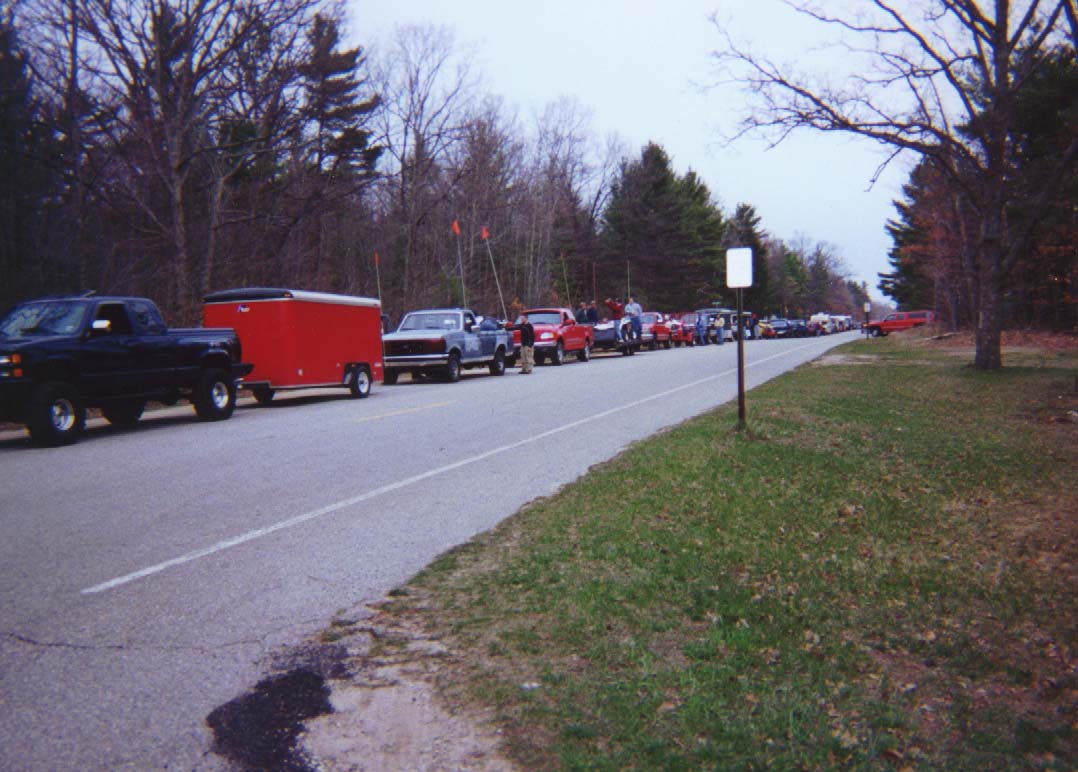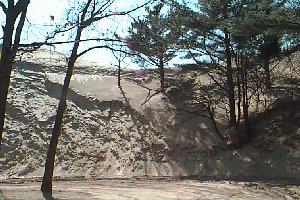Silver Lake Dunes, a state park along the Lake Michigan coast, is a very popular spot for people interested in driving dune buggies, trucks, or motorcycles on active sand dunes. The Silver Lake Sand Dunes attract thousands of visitors each year. Hence, the line for this popular park can stretch for miles! All vehicles need a state park sticker. All vehicles going onto the dunes need an orv sticker, and their tires must be deflated and the exhaust systems must meet noise requirements.

Source: Image Courtesy of Jo Haines, Former GEO 333 Student
These beautiful but fragile dunes give enjoyment in many ways to the tourist as well as
the local people. Hiking is great fun and gives good exercise, too. Be sure to wear shoes
and take a water bottle on those hot days. Many types of dune buggies are seen on these
sand dune mountains daily, between April 1 through November 1, the time when the dunes are
open. Hiking is allowed year round.
Sand is usually moved by the process known as "saltation" in
which individual grains move in a bouncing, skipping course of violent collisions. The
particles themselves, very seldom get more than one foot off the ground. In this process,
the sand can exert considerable abrasive action on metal, wood, glass and boulder.

Source: Image Courtesy of Jo Haines, Former GEO 333 Student
The Silver Lake Sand Dunes are 1.5 miles wide and 3 miles long, making about 1875 acres of
rolling sand hills. They are considered one of the largest deposits of living dunes on the
shores of Lake Michigan.

Source: Image Courtesy of Jo Haines, Former GEO 333 Student
Within these dunes are wetlands with tree growth of many kinds, making homes for the
animals found there. Fox, deer, raccoon, porcupine, white owl, the great blue heron, and
many more animals and birds can be seen in these areas at different times of the day.

Source: Image Courtesy of Jo Haines, Former GEO 333 Student
The primary stabilizer of the sand dunes is the marram grass, commonly called dune grass.
The underground stems reach down to the water table and then back upward to form new
plants. This underground network serves to hold the sand in place. Other vegetation on the
dunes is sand reed grass, bluestem, hairy puccoon with its yellow flowers, bearberry, and
other grasses. Jack pine, white pine, juniper, wild cherry, birch and poplar trees are
seen in the dune area. Many trees have been buried with only their tops showing, caused by
the shifting sands, thus, they look like bushes.
Tourism
Tourism in Silver Lake started in the early 1920's as cottages popped up, and folks,
especially from Illinois, started vacationing here. At that time, the people usually came
by train into the Mears train station. They and their trunks would be brought to the lake
by horse and buggy. They usually stayed the whole summer. Because the number of
vacationers increased, other facilities were in demand. So campground, stores, and
entertainment were started. Mac Wood's Dune Scooter Rides began in the 1930's as part of
the entertainment for guests of Flora Dale Family Resort.
The dunes are divided into three sections: the northern end is for the
off road vehicles; the middle section is for the hikers; and the southern end is leased by
Mac Wood's Dune Rides for the commercial business.
Silver Lake (see above) is a busy lake for fishing, skiing, swimming, jet skiing,
parasailing, and other water activities. The lake is perfect for small children to swim.
On the south side the water is shallow for many yards beyond the beach. The north
side, however, has a dropoff created by migration of the sand dunes into Silver Lake. This
area of the lake is good for swimmers and water skiers. Silver Lake's deepest part is
about 22 feet. The lake is approximately one mile by 2 1/2 miles in size.
Thanks to Jo Haines who inspired this page and provided some of the material on it.
This material has been compiled for educational use only, and may not be reproduced without permission. One copy may be printed for personal use. Please contact Randall Schaetzl (soils@msu.edu) for more information or permissions.